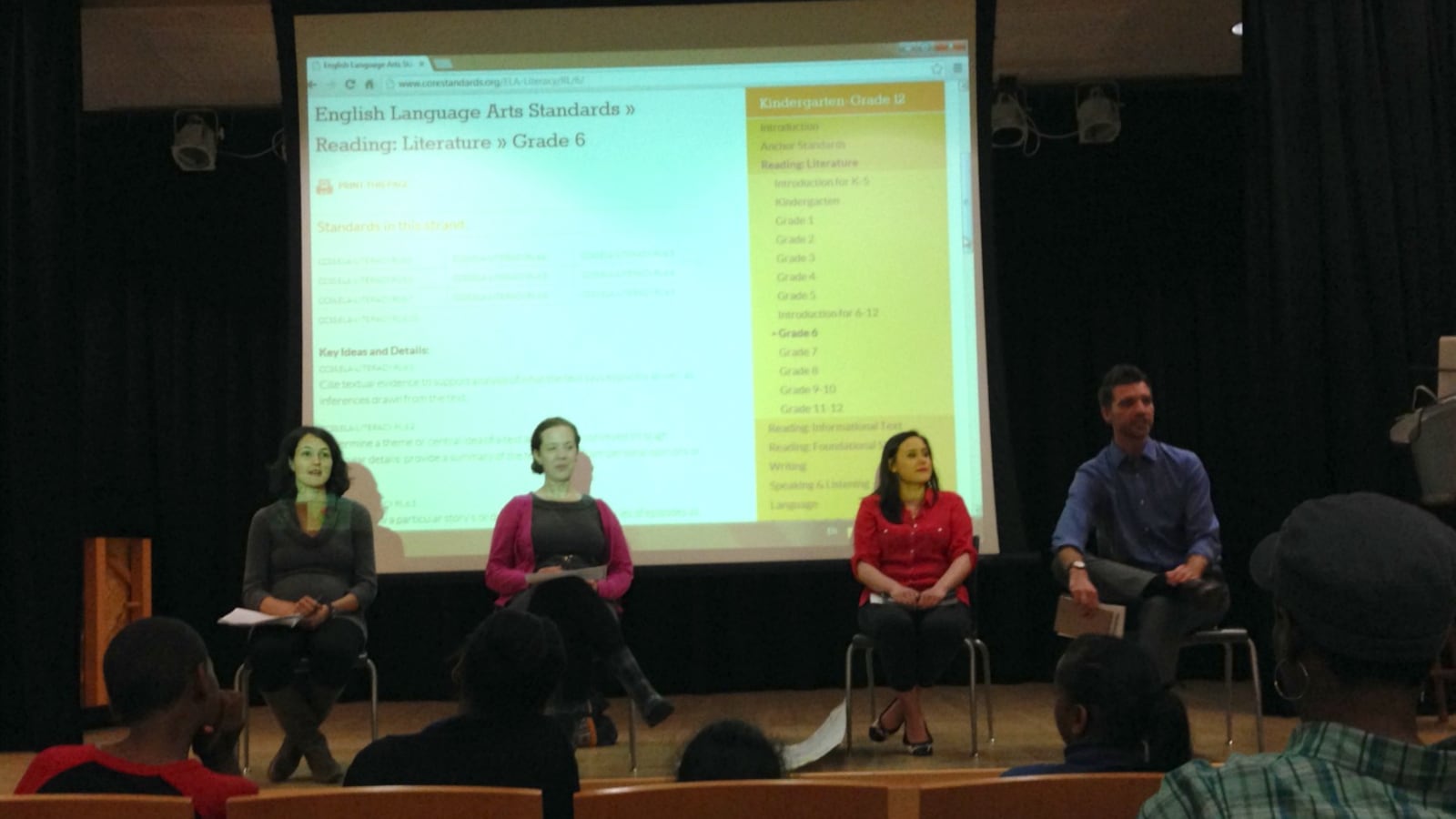Three women sat on a stage in the Bronx Library Center last week and read from a scene where a young girl embraces her mother after a yearlong separation.
What might have looked like a dramatic reading was actually a close reading: The women were public middle school teachers demonstrating how students analyze texts in the age of the Common Core learning standards.
After the brief model lesson, the teachers discussed the way the standards are playing out in their classrooms and what that means for students. Chalkbeat facilitated the conversation among the teachers — Meredith Jacks, from the Academy of Arts and Letters in Brooklyn; Catherine Miller, from the New School for Leadership and the Arts in the Bronx; and Anna Staab, from the Highbridge Green School in the Bronx — in order to give parents a glimpse into Common Core-aligned reading classrooms.
Here are some highlights from their discussion:
1. Rigorous, sure, but Common Core work can be exciting and provocative too
Each of the teachers has found ways to make high-level Common Core reading work engaging, in part by supplementing publisher-designed units with other texts and projects.
Staab’s sixth-grade English class kicked off a recent unit on agriculture by comparing the practices on industrial farms to those on local ones, and the students will eventually visit an urban farm. Now they are reading scientific articles about pesticides alongside a novel, “Frightful’s Mountain,” where a falcon encounters the pesticide DDT.
Jacks, an eighth-grade co-teacher who works with students with special needs, said she spent a full class period recently parsing the first page of “Dr. Jekyll and Mr. Hyde” with a student. They scrutinized strange words and references and interpreted the details provided about a character.
Miller’s sixth-grade honors English class recently analyzed a poem about Hurricane Katrina as part of a larger unit about natural disasters.
“Students feel really empowered,” Miller said. “It’s not the story or poem that’s running them, they are running the story or poem.”
2. Common Core-inspired writing is just the inverse of reading
Students must now learn to interrogate texts, the teachers said, asking who wrote them, how, and why. It’s no longer enough just to point out a metaphor — students must now explain how the author wielded it to make a larger point.
Studying the way writers work comes in handy when it’s students’ turn to write, the teachers said.
“All the things we want students to notice that an author did when they’re reading,” Jacks said, “they have to do those things when they’re writing.”
3. Students should root their interpretations in the text
Forget what you think about a text, the Common Core wants you to show what you know, the teachers agreed. And that requires “textual evidence.” (In a conversation before the panel, Jacks said she is tempted to get “Show me what makes you say that” tattooed on her forehead.)
Staab said that skill is crucial because it’s “at the heart” of what students must do in college. Miller put it more bluntly.
“I say this with a lot of love: It doesn’t matter what you think about a piece of writing,” she told the audience. “It’s, ‘Let’s see you prove it.’”
4. But that doesn’t mean students should stuff their feelings in a locker
At one point, a college student in the audience noted that poems and other texts are meant to elicit emotions, which might lead a reader to a deeper understanding. With its “prove it” ethos, he asked, does the Common Core make room for such subjective reading?
Staab responded by recalling a recent literary festival she attended where audience members called out, cried, and then sat stunned after a powerful reading. She said that reminded her that good readers respond to texts as analysts, certainly, but as people too.
“As an English teacher, it can be really fun to break things down part by part,” she said. “But that can’t be the only avenue we have to experience texts.”


